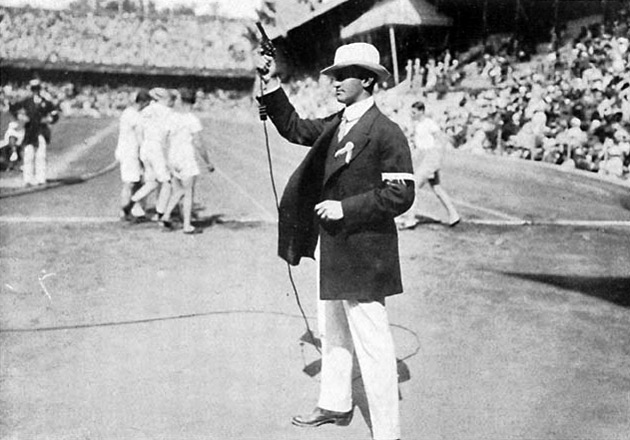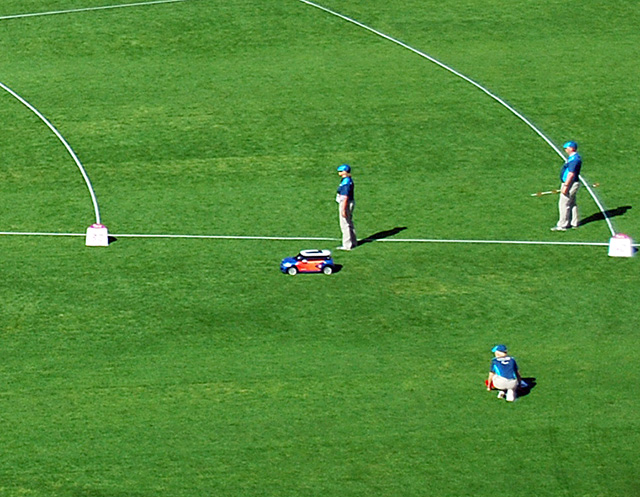Over the more than 100 years since the first modern Olympic Games, there has been a dramatic increase in the use of technology around the world, and there are many examples of its use associated with the Olympic Games.
 Starter for the track events of 1912, showing the starting pistol connected to the electronic timing system. (from the 1912 official Olympic Games report)
Starter for the track events of 1912, showing the starting pistol connected to the electronic timing system. (from the 1912 official Olympic Games report)Photography and Film
In the early days of the development of film, this new technology was already being utilized in the analysis of Olympic athletes. At the 1900 Olympic Games in Paris, Etienne Jules Marey used a new technique called chronophotography to analyze the movement of athletes (see more). Marey was a pioneer in chronophotography, a photographic technique which captures movement over several frames, which can be subsequently arranged like an animation, enabling analysis of the athletes' movements.
The telecast of the Games around the world has played an important part of the globalization of the event. The first Games to be televised were the Berlin Olympics in 1936. The telecast of events was shown on large screens around Berlin. The first Olympic Games to be telecast into homes were the 1948 London Game which transmitted the telecast within the British Isles. The first Olympic Games to be covered by television worldwide was the Rome Olympics in 1960. Tokyo 1964 were the first Games to be televised internationally without the need for tapes to be flown overseas. The Olympic Games were telecast to the United States using Syncom 3, the first geostationary communication satellite, and from there to Europe using Relay 1.
Timing Systems
From the first modern Olympic Games in 1896, stopwatches were used to determine the winners' times. In 1912, an electronic automatic timing system was introduced for the athletics track events. The device was invented by Swedish engineer Ragnar Carlstedt. The timer began by the firing of the starter's pistol, and stopped manually by a timing official allocated for each runner. The system also included a photo of the winner as they crossed the finish line. The timing technology used at the Olympics continued to develop. The early stopwatches only timed to 0.2 of a second. In the 1920's, chronographs were first used to measure to the hundredth of a second.
The next step in timekeeping in 1932 with the "Kirby camera", designed by Omega, which simultaneously photographed the finish line and imprinted the time on each frame. The 1948 Olympics saw the introduction of another innovation with the continuous slit camera, which is the basis of all athletics timing systems used today. Four years later the time was connected to the slit camera giving a resolution of 1/100 s, though it was not until 1972 that official times were recorded to the 100th of a second. In London 2012: London, the Quantum Timer was introduced, able to measure accuracy to one millionth of a second.
In 1964, the competitors' times were first shown live on television, and in 1976 electronic scoreboards used for display of real-time scores. GPS was used or the first time in rowing competitions in 2008, allowing viewers to see the progress as the race progressed.
Other sports also had significant changes in timing systems. In the pool, contact plates were first used to time the swimming events in 1968. Other sports required infrared beams to determine finishing times.
 In London 2012, Small remote control mini cars were used to return the javelins
In London 2012, Small remote control mini cars were used to return the javelins Scoring Systems
There have been some innovations recently for the sport of taekwondo, utilizing technology to get a fairer scoring system and more spectator engagement. In 2012, there were sensors placed in the vests which were activated by magnetic socks to record successful hits. In 2016, there will also be sensors in the headgear. The signals are transmitted by wireless. For the first time the athletes will be able to request a video replay during the contest, for whenever there is a doubt on the mat.
Gaining An Advantage
Technology has been at the forefront of advances in sporting performance, with improvements in areas such as equipment design, uniforms, footwear, running surfaces and stadiums
Any enhancements must still be within the rules of the sport. In track and field, athletes are obviously not allowed to have additional mechanical assistance. An interesting example is disabled athletes wearing prosthetics. Disabled athletes attempting to compete alongside their able-bodied counterparts are required to prove it does not give them an advantage. In 2012, South African sprinter and amputee Oscar Pistorius was the first athlete to compete at the Olympic wearing high tech blades. Leading up to his participation, there were questions about whether they gave him an unfair advantage. He was required to undergo numerous investigations, and was eventually allowed to compete, though in the future athletes wearing more advanced blades may not.
While performance-enhancing drugs have been used for a long period at the Olympic Games, it was only in the 1960s that the danger was highlighted and a concerted effort was made to stop doping. The first Olympic athlete to test positive for the use of a performance-enhancing drug was in 1968, in this case alcohol. As the technology and testing techniques improved, the number of athletes discovered to be doping increased as well. Drug testing methods have had to continually advance to keep pace with the development of more ways to cheat.
Related Pages
- Science and the Olympics
- The Future of the Olympic Games: Embracing Technology
- Biomechanics of Olympic Athletes in 1900
- Drug testing at the Olympics
- Anthropometry and the Olympic Games
- Technology in Sports


 Upcoming Events
Upcoming Events